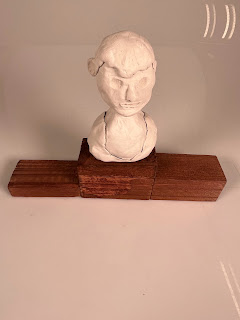Cabinet of Curiosity
Evan Gallagher Design
Sunday, December 11, 2022
Cabinet of Curiosity
Memento
Memento
Artist Statement:
As a child one of my best friends used to bring his Rubik's cube to school every morning and ask me to scramble it for him. To my amazement he would solve it, usually in under a minute. Eventually I asked him to teach me and with his help I would learn how to solve it myself. From then we would race and see he could solve their cube faster. Since then I have always enjoyed puzzles of any kind and credit my friend for this.
Figurative Bust Sculptures
Figurative Bust Sculptures
Experimental Sculpture Collection
Experimental Sculpture Collection
Sculpture 1
Materials: Balsa wood, black ink, paper, and yarn
Sculpture 3
Materials: Wood glue and black ink
Tuesday, November 1, 2022
To Have and to Hold: An Intimate History of Collectors and Collecting
To Have and To Hold: An Intimate History of Collectors and Collecting
Angelus Novus
Chapter Overview
- Dr Franz Joseph Gall (1758-1830), a German Physiologist, made the discovery that different types of brain activity are located in different parts of the brain.
- As a result, Gall believed that parts of the brain that were more developed than others impacted the growth of a person's skull.
- Gall collected numerous human skulls as well as plaster casts, from both the living and deceased, as a way of studying the development of the brain and its impact on skull growth and shape.
- The science of phrenology, the study of a person's skull size as a means of measuring mental capacity, became both extremely popular and controversial. As a result Austria's Catholic Emperor, Franz II, prohibited the teaching of the science anywhere.
The Chapter mentions that Dr. Gall happened to have a collection of plaster casts. Most of the faces are molded from criminals or those deemed insane. However, Gall happened to have several belonging to some well known people of the time, Napoleon being one of them.
There exists however, not one but two official "Death Masks" belonging to Napoleon. The actual masks themselves are a mystery due to the fact that there is very limited documentation of why they exist in the first place. To this day historians have found minimal evidence that points them in the direction of the mask's origin.
Sources
https://www.napoleon.org/en/history-of-the-two-empires/close-up/napoleons-death-mask/
https://library.unc.edu/wilson/gallery/napoleon/
https://ageofrevolution.org/200-object/death-mask-of-napoleon/
Image 2
Crown of Angelo Solimon
Tuesday, August 30, 2022
A Few of My Favorite Things
Cabinet of Curiosity
Cabinet of Curiosity Artist Statement: Phrenology was a late 19th century physiological science. The study served as a pseudo-neuroscience...

-
Cabinet of Curiosity Artist Statement: Phrenology was a late 19th century physiological science. The study served as a pseudo-neuroscience...
-
To Have and To Hold: An Intimate History of Collectors and Collecting Angelus Novus Chapter Overview Dr Franz Joseph Gall (1758-1830), a G...
-
A Few of My Favorite Things 1. Running Shoe: I've been running for as long as I can remember. Every year and every season in High Sch...



































